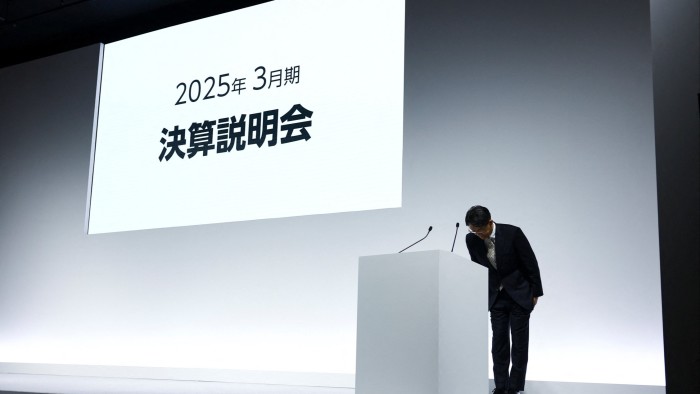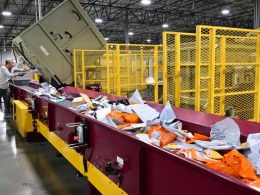Japan’s largest companies have said tariffs planned by the Trump administration could erode annual profits by tens of billions of dollars, with the probability of a bigger impact in the event of a US recession.
Groups including Toyota, Sony and Mizuho could suffer a total hit as high as ¥4tn ($27.6bn), according to Financial Times calculations based on company guidance during the current full-year earnings season.
The total could rise, with many companies refusing to provide estimates, citing “extreme uncertainty”, and some still to report.
With executives at leading industrial groups reporting a massive impact from tariffs, pressure is increasing on the country’s negotiators to secure a deal to lower levies, analysts said. Chief negotiator Ryosei Akazawa plans a third round of talks with US Treasury secretary Scott Bessent by the end of the month.
Japanese car companies, as well as steel and aluminium producers, are subject to tariffs of 25 per cent on US imports, while other sectors have 24 per cent levies on their goods as part of President Donald Trump’s “reciprocal” tariffs.
The automotive industry, Japan’s biggest export sector, is the most exposed. In 2023, Japan shipped 1.5mn vehicles to the US, worth more than $40bn, and car manufacturers ship many vehicles and parts into the US from Mexico and Canada, which have also been stung by tariffs.
“The impact of tariff policies is huge,” said Toshihiro Mibe, chief executive of Honda, which predicted ¥650bn ($4.5bn) of extra costs and has slashed its investment plans to 2030 by ¥3tn ($20bn) to ¥7tn.
Toyota is the hardest hit, estimating an impact of $1.2bn in April and May.
The $27.6bn total was calculated by adding up tariff impact figures provided by the country’s top 100 largest groups by market capitalisation, car companies and others that cited a large impact, in their earnings presentations or calls.
Most of the estimates given by Japanese groups assume no measures to offset the charges such as a product price rise. When a range was given, the middle estimate was taken, and when the impact was said to be “several billions of yen”, it was assumed to be ¥3bn.
For Toyota and Mazda, the annual impact was extrapolated from the monthly figure for the remainder of their financial year, which resulted in a total that was lower than estimates made by SBI Securities.
The earnings also revealed large vulnerabilities across the rest of Japan, despite efforts over decades to localise production in the US, and many companies not putting a figure on the potential pain.
Tadashi Imai, president at Nippon Steel, which is still attempting to buy US Steel for $15bn and declined to estimate the tariff blow, said the levies were “expected to have a tremendous impact on the domestic and overseas steel industries, including indirect effects”.
Many companies said they could take countermeasures to soften the impact by raising prices or shifting more production to the US.
“In the medium to long term, we would like to change the source of product supply and become more efficient to reduce the impact of tariffs,” said Takuya Imayoshi, president of Komatsu, which has been a target of Trump’s ire for many years over its competitively priced excavators.
A lengthy period of tariffs would probably mean a much larger financial hit, with leaders of many companies saying no reliable estimate could be provided, given the volatility and uncertainty over their implementation.
“There is no point in just reporting numbers when we have no idea what the underlying assumptions are,” said Ryo Hirooka, chief financial officer of Hoya, a glasses and contact lens manufacturer, 15 per cent of whose sales are generated in the US.
Others have put in provisional “buffers” to account for extra tariff-related costs, such as the ¥40bn given by the trading house Sumitomo Corporation. President Shingo Ueno said: “This is the first time ever that we have announced our results with a buffer factored in [to the forecast] from the very beginning. I think that alone shows how extremely uncertain the situation is.”
There is also a risk that Japan’s economy could be steered further off course. Figures released on Friday showed Japanese GDP turned negative in the January-to-March period from the previous quarter, even before the US tariffs had begun to show in the export numbers.
While broadly in line with market expectations, the 0.7 per cent annualised quarter-on-quarter contraction highlighted fragility, said analysts.
Japan’s trade negotiations with the US appear to have lost some of their early momentum and corporate leaders are urging the government to accelerate efforts to strike a deal.
“I would expect that they move faster, to be very honest,” said Nissan chief executive Ivan Espinosa. “We do need to get clarity as soon as possible.”
Source link









